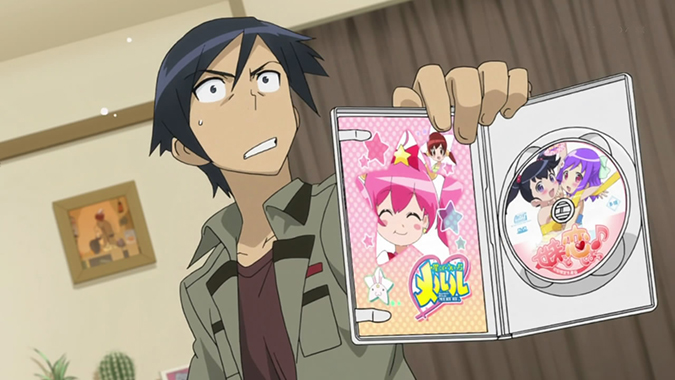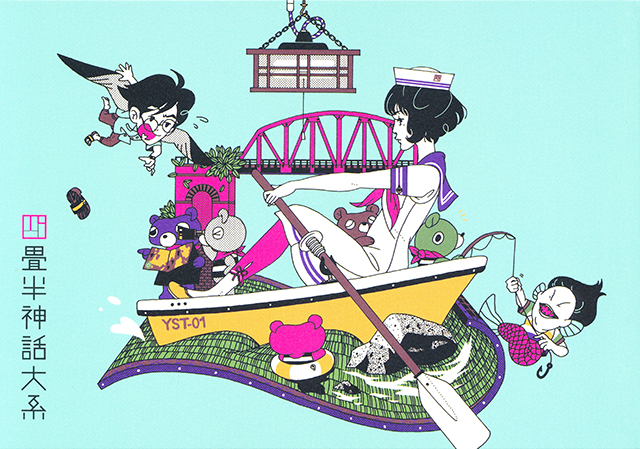Deep in the murky past, the most common method of (legally) watching anime in the US was buying physical media. The format changed over time from wallet-draining VHS tapes to single DVDs, then mercifully to reasonably priced box sets. What you got and how much you paid for it varied from year to year, but one thing was always true: once you bought something, you could (and probably did) binge-watch the whole damn thing. With the advent of streaming simulcasts, we now have the option of watching a new episode of a series each week, just like one might do with new episodes of American TV. With these two options having co-existed for over five years, now seems as good a time as any to ponder how each method influences the viewing experience.
That’s right, REAL discs that cost REALLY large amounts of money.
Whether it’s sitting down for a streaming catch-up marathon or cracking open a newly released Blu-ray set, there’s something about The Binge that appeals to the otaku inside us all. It takes planning, commitment, and a depressingly blank social calendar to watch anime for hour after hour until your eyes are bloodshot and your muscles refuse to move. Being a geek of any kind suggests a proclivity for over-indulging in your hobby of choice, and anime marathons are a perfect example of choosing passion over common sense. Apart from a handful of ego points, though, what do we gain from this style of viewing?
One of the main advantages of The Binge is that the viewer goes into each new episode with the memory of previous events fresh at hand. We spend less time trying to recall what’s going on, allowing us to focus more of our attention on what’s happening in the moment. Emotions run higher, subtle nuances are more obvious, and the experience as a whole is more immersive. For this reason, marathons can be a great way to watch complex or dramatic shows with lengthy plot arcs.
Sometimes, an anime series will also feel like it was made to be watched in one or two sittings. My most recent experience with this came with The Tatami Galaxy, which I decided to finally check out after enjoying last season’s Ping Pong (both series have the same director). The Tatami Galaxy relies heavily on repeated visuals and lines of dialogue, as the story revolves around a college student living out alternate versions of his life depending on what club he chooses to join in his freshman year. The show gets stranger and more unsettling with each passing episode, and watching multiple episodes in a row greatly enhanced the feeling of being trapped in an endless loop. Looking back, I wouldn’t have enjoyed The Tatami Galaxy as much as I did if I hadn’t crammed the series into a handful of late night binges.
Gosh, I’d love a double-feature set of this and Ping Pong. Looking at YOU, Funimation.
On the other hand, there’s always the risk that an anime series will wear out its welcome halfway through a marathon, leaving the viewer too burnt out to finish. Many shows, especially ones with episodic plots or those that rely heavily on one or two appealing elements, don’t hold up well when watched as a single chunk of time. In cases like these, the weekly simulcast (or just not doing a full marathon) can be the way to go. I don’t think I’d want to watch more than one episode of this season’s gag comedy Sabagebu! at a time, but it’s entertaining enough that I’ll give it half an hour a week. Slice of life series, rapid-fire comedies, and even sports anime are all a bit like shots of whiskey; they’re fine in moderation, but too much at once will kill you.
The simulcast style of viewing also comes with a nice side benefit: staying current with a show means you can talk about it with other people without worrying about spoilers. If everyone in the world has only seen up to episode 19 of Haikyu!!, then that means we’re all coming from the same place when we discuss how much fun it is to watch the characters get REALLY EXCITED about volleyball. The simulcast style of viewing can provide a great deal of conversational currency as folks chat about what’s happened so far and what future episodes might hold. While the marathon embodies the passionate excess of geek life, the weekly simulcast fuels its iconic (and constant) debates.
As much as I’m able to generalize about which method benefits particular genres, the best way to watch anime is however you damn well please. If you want to watch the entirety of Yuruyuri in one day, go for it. If you want to drag out the original Evangelion TV series over half a year, enjoy. Some of the best otaku war stories come from experiencing a series in an unusual way, so don’t be afraid to break from the formula whenever you feel like it.
Kawaii Overthink is written by Paul Jensen. You can follow his ramblings about anime and manga on Twitter. Check back every other Wednesday for new articles.

